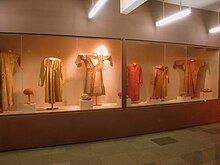Angarkha

Angarkha is an outer robe with long sleeves which was worn by men in South Asia.[1] By the 19th-century it had become the generally accepted attire of an educated man in public.[2][3] It had evolved from the Persian cape balaba or chapkan as a result of being given a more Indian form in the late medieval or early modern era.[4][5][6]
Etymology
[edit]Angarkha comes from the Sanskrit aṅgarakṣaka, meaning 'body-protector'.[7]
See also
[edit]References
[edit]- ^ Tarlo, Emma (1996), Clothing Matters: Dress and Identity in India, University of Chicago Press, p. xi, ISBN 9780226789767,
angarkha: Long-sleeved long coat worn by men
- ^ Tarlo, Emma (1996), Clothing Matters: Dress and Identity in India, University of Chicago Press, p. 28, ISBN 9780226789767,
The comparatively limited range of stitched clothes available in pre-medieval India was, however, greatly expanded during the Sultanate or Moghul periods when various types of trousers, robes, and tunics gained popularity. By the 19th-century a long-sleeved outer robe (jama, angarkha) or tunic (kurta) worn with trousers (pyjamas) had become the acceptable outfit for an educated Indian man in public, if not in private.
- ^ Qureshi, Regula Burchhardt (6 May 2016), Master Musicians of India: Heriditary Sarangi Players Speak, Routledge, p. 295, ISBN 9781135873974,
Glossary. angarkha — a long tunic or coat tied on one side, formal dress of 19th-century provenance
- ^ Tarlo, Emma (1996), Clothing Matters: Dress and Identity in India, University of Chicago Press, p. 47, ISBN 9780226789767,
The historian Abdul Halim Sharar ... shows how the Persian cape (balaba, chapkan) was gradually given a more Indian form (angarkha)
- ^ Dasa, Syamasundara (1975), Hindi sabdasagara, Kashi: Nagari Pracharini Sabha, 1965–1975, in many volumes,
एक पुराना मर्दाना पहिनावा जो घुटनों के नीचे तक लंबा होता है और जिसमें बाँधने के लिये बंद टँके रहते हैं । बंददार अंगा । चपकन । (Google Translate) An old masculine dress that is long below the knees and in which there are closed stitches to tie. ... Chapkan
- ^ Jirousek, Charlotte A. (2019), Ottoman Dress and Design in the West: A Visual History of Cultural Exchange, Indiana University Press, p. 23, ISBN 9780253042194,
The Turko-Mongol forms of dress were first established, along with Islam, in northern India by Turkic Gaznevids who invaded from Central Asia in the eleventh and twelfth centuries. The Mughal (Timurid) conquest in the sixteenth century confirmed these forms of dress in a land otherwise known for the unseamed dhoti and sari. For men of the Mughal court trousers (paijama) were typically combined with front-opening coats or jackets of varying length and cut (angarkha or jama) but typically were more full-skirted than most Persian or Turkish equivalents. The relation to Persian dress is strong, however.
- ^ Zaira Mis, Marcel Mis (2001) Asian Costumes and Textiles: From the Bosphorus to Fujiama [1]
Clothing in South Asia | |
|---|---|
| Clothes |
|
| Headgear | |
Stitching and design | |
| Footwear | |
Text is available under the CC BY-SA 4.0 license; additional terms may apply.
Images, videos and audio are available under their respective licenses.
